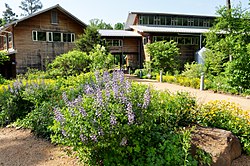North Carolina Botanical Garden
hideThis article has multiple issues. Please help or discuss these issues on the talk page. (Learn how and when to remove these template messages)
|
 | |
| Date opened | 1951 |
|---|---|
| Location | Chapel Hill, North Carolina |
| Coordinates | 35°53′57.71″N 79°2′1.98″W / 35.8993639°N 79.0338833°WCoordinates: 35°53′57.71″N 79°2′1.98″W / 35.8993639°N 79.0338833°W |
| Land area | 700 acres (1.1 sq mi; 2.8 km2) |
| No. of species | 2,500 |
| Website | www |
| Wikimedia Commons has media related to North Carolina Botanical Garden. |
The North Carolina Botanical Garden (about 700 acres (2.8 km2), plus 210 acres (0.85 km2) of nature preserves) is a botanical garden operated by the University of North Carolina at Chapel Hill in Chapel Hill, North Carolina. The primary goal of the Garden is to research, catalog, and promote the native plant species of North Carolina.
History[]
The history of the Garden begins in 1903, when Professor William Chambers Coker began planting trees and shrubs on the central campus (now Coker Arboretum). In 1952, the Trustees of the university dedicated 70 acres (280,000 m2) forested for development of a botanical garden. An additional 103 acres (0.42 km2) were donated by William Lanier Hunt. Considerable additions and expansion of the Garden took place from the 1960s onward. A recent expansion effort is the James and Delight Allen Education Center, designed by architect Frank Harmon, the first LEED Platinum certified state-owned building or public museum in North Carolina.[1][2]
The Garden today[]
Today the Garden comprises 14 collections and display gardens, containing some 5,900 accessions representing about 2,500 species of the 4,700 plant species known to be native or naturalized in North and South Carolina. It has become one of the largest native plant botanical gardens in the Southeastern United States.[3] Admission is free. The Garden is open Tuesday through Sunday, with special educational programs offered regularly. Highlights of the Garden include:

- Battle Park, 90 acres (360,000 m2) – forest land in the center of the Chapel Hill.
- Carnivorous Plant Collection – an acclaimed collection of carnivorous plants, including butterworts, pitcher plants, sundews, and Venus Flytraps
- Coastal Plain and Sandhills Habitat Gardens – representing the ecosystems in the eastern part of North Carolina.
- Coker Arboretum
- The Fern Collection, containing Southeastern fern species.
- Garden of Flowering Plant Families – a traditional botanical garden, showing evolutionary relationships between flowering plant groups.
- Horticultural Therapy Demonstration Garden – heirloom vegetables and flowers varieties in plantings designed for persons with limited mobility and reach.
- The Mercer Reeves Hubbard Herb Garden — some 500 species, including 52 Rosmarinus officinalis cultivars, arranged in a Culinary Garden, Economic Garden, Medicinal Garden, Native American Garden, and Poison Garden.
- William Lanier Hunt Arboretum
- Mason Farm Biological Reserve, 367 acres (1.5 km2) – natural area.[4]
- Mountain Habitat Garden – plants and trees characteristic of the mountainous areas of the southern Appalachian mountains at elevations ranging from 1,500 feet (460 m) to 6,684 feet (2,037 m).
- Native Plant Border – native perennials, shrubs, and small trees.
- Native Water Gardens – Nymphaea odorata and Nelumbo lutea, as well as Pontederia cordata, and many others. All aquatic plants are native to the southeastern United States.
- UNC Herbarium (earliest collections 1835) – 750,000 natural history specimens documenting the identity and distribution of plants in North Carolina and the Southeast.
The garden also contains a cabin in which playwright and professor Paul Green (1894–1981) performed most of his research and writing. It was moved to the garden in 1991.[5]
See also[]
- List of botanical gardens in the United States
References[]
- ^ "North Carolina Botanical Garden: Education Center". Archived from the original on 2012-11-08. Retrieved 2012-11-09.
- ^ "About: Education Center". North Carolina Botanical Garden. Archived from the original on November 8, 2012. Retrieved November 9, 2012.
- ^ "North Carolina Botanical Garden". VisitNC.com. Retrieved 2018-01-04.
- ^ Cook, Will. "Mason Farm Biological Reserve". Triangle Birder's Guide. Carolina Bird Club. Retrieved 19 January 2017.
- ^ White, Peter. "North Carolina Botanical Garden". NCPedia. UNC Press. Retrieved 18 January 2017.
- A Walk through the Display Collections, North Carolina Botanical Garden, brochure dated September 2003.
External links[]
- Botanical gardens in North Carolina
- University of North Carolina at Chapel Hill landmarks
- Protected areas of Orange County, North Carolina

